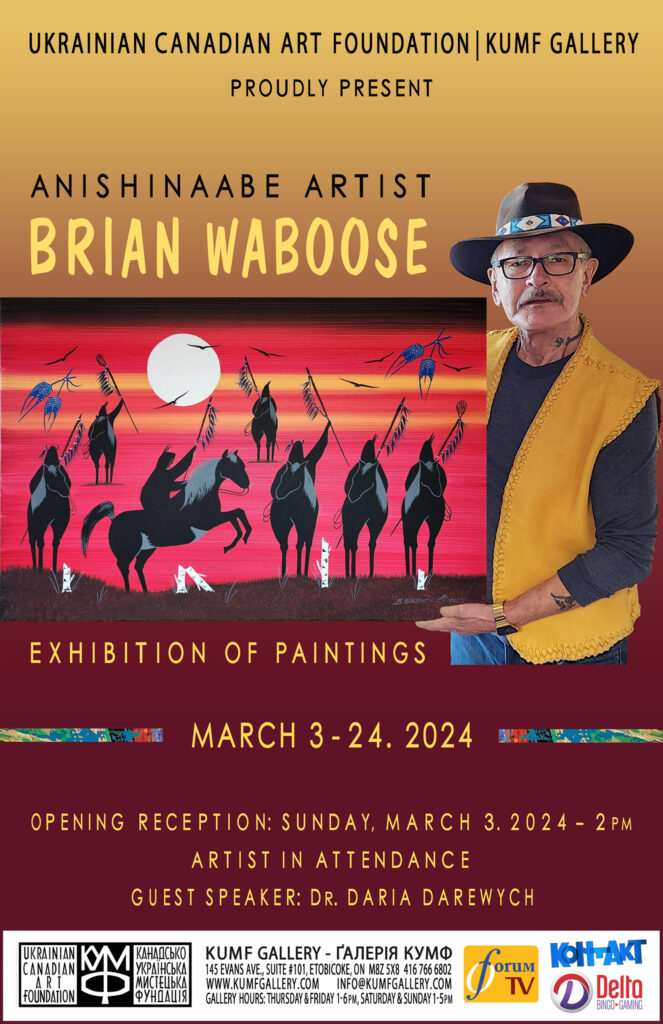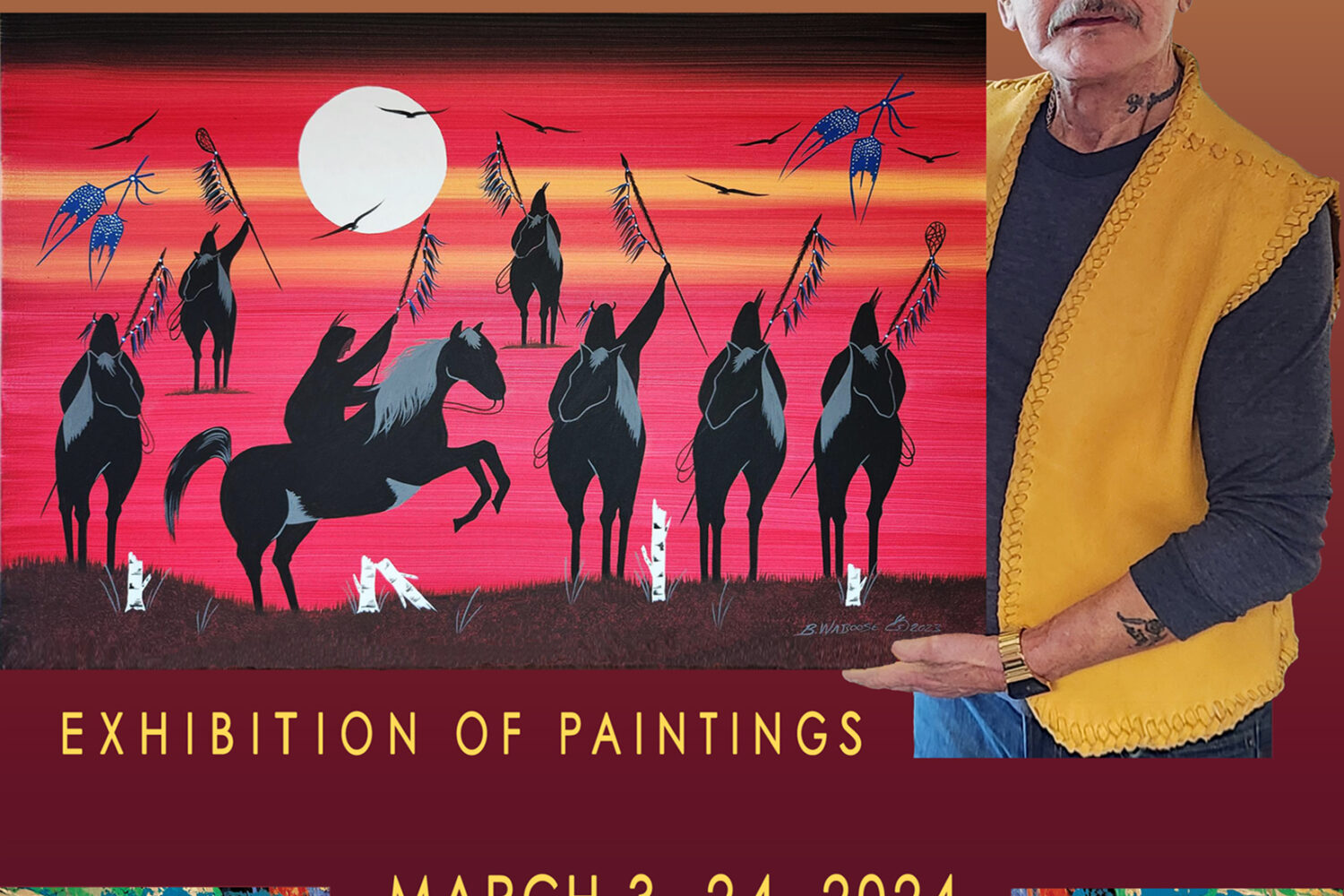Art Exhibition by Brian Waboose. March 3-24, 2024
by

Ukrainian Canadian Art Foundation’s KUMF Gallery is pleased to feature the solo exhibition of Anishinaabe artist, Brian Waboose from March 3 – 24, 2024, and reintroduce a gifted Indigenous artist known for his colourful paintings and carvings. This showcase explores a range of themes that highlight Brian Waboose’s interests and unconventional career path.
A self-taught artist painting in the Woodlands style, this presentation offers an opportunity to experience Mr. Waboose’s vibrant imagination combining traditional legends and myths. Symbolism features prominently in much of his work and proposes another view of the world around us, and are a catalyst for dialogue optimistically inspiring new meaningful relationships. “We are pleased to showcase Brian Waboose’s solo exhibition and present this comprehensive oeuvre. Brian captures the spirit of the Anishinaabe through his use of familiar and traditional images. He engages the viewer in a warm atmosphere of family reunion, while highlighting the feeling and longing for home and stability during these difficult and tumultuous times.” remarks, Christina Kudryk, Board Director and Art Committee Member.
Expanding the role of artist in our society and perception of contemporary art, on the first anniversary year of the war on Ukraine by Russia, Brian Waboose created and donated a unique and powerful work, The Seven Grandfathers’ Teachings: Respect, Love, Bravery, Honesty, Truth, Wisdom, and Humility dedicated to the Ukrainian people and in support of their brave stand against Russian aggression. This painting is part of The Ukrainian Canadian Art Foundation’s Permanent Collection.
Join Us for the Opening Ceremony – Sunday, March 3, 2023 @ 2:00 p.m. Exhibition Dates – March 3 – March 24, 2024. KUMF Gallery – 145 Evans Ave. Suite 101, Etobicoke, ON M8Z 2X8 Brian Waboose will be in attendance. Join Us!
About Brian Waboose – https://brianwaboose.com, is a talented Anishinaabe artist and member of the Whitefish River First Nation known as Birch Island in northern Ontario.

BRIAN WABOOSE EXHIBITION OPENING, KUMF Gallery, March 3, 2024
It is a pleasure and an honour to be speaking at the opening of the first solo exhibition of Indigenous art in a Ukrainian Canadian art gallery. Brian Waboose, a talented Anishinaabe artist, and a member of the Whitefish River First Nation known as Birch Island in the Manitoulin Island District of northern Ontario, came to attention last year when he dedicated one of his paintings to Ukraine and in support of its brave stand against Russian aggression. The acrylic painting titled The Seven Grandfathers’ Teachings: Respect, Love, Bravery, Honesty, Truth, Wisdom, and Humility featured seven Indigenous horsemen with eagle feathered staffs against a backdrop of blue and yellow of the Ukrainian flag. By presenting traditional Indigenous cultural images and myths against a background symbolic of Ukraine’s independence Brian Waboose created a unique and impressive work, a work in keeping with Indigenous art traditions and the reality of today.
It was a Canadian first in terms of subject matter in the visual arts field and a first in terms of the artist’s heritage. No other artist had ever created a work representing traditional Indigenous cultural images and myths against a background symbolic of Ukraine’s independence. It was also a first in contemporary Ukrainian-Indigenous cultural relationships.
As we all know, Brian Waboose donated this painting to the Ukrainian Canadian Art Foundation in Toronto at an official ceremony in April last year. To mark this milestone in Ukrainian Indigenous cultural relations, KUMF gallery offered to host his solo exhibition to provide the Ukrainian Canadian community, as well as others with an opportunity to explore and appreciate Brian Waboose’s art.
Brian Waboose was born in 1955 at Chapleau, Ontario. He spent his early years at the Pic-Mobert Reserve in the Thunder Bay area where he spent many winters trapping with his parents and grandparents. After the death of his father when Brian was nine years old, he was placed in St. Joseph’s Training School for boys where he suffered terrible abuse and lost his Indigenous culture which was beaten out of him in residential school. At age 22 he began rediscovering and exploring his Anishinaabe heritage and started painting.
Since 1977 he has been painting in what is recognized as the Woodland School of Indigenous art. This pictographic style with an emphasis on outlines and x-ray views was inspired by birch bark scrolls created by Indigenous shamans and by petroglyphs found on rocks in Northern Ontario. Marked by expressive form-lines, a system of transparency, and interconnecting lines, this style originated in the late 1950s and early 1960s with Norval Morriseau, the most prominent, iconic, and very prolific Indigenous artist in Canada.
Unlike most prevalent European visual arts traditions of depicting what the eye sees in a three-dimensional world with representations on a two-dimensional surface, the pictographic style of painting emphasizes the transfer of Indigenous knowledge, beliefs, and values, and does so through symbols and images conveying spiritual meaning.
So instead of 3d renderings of landscapes, objects, and figures we see outlines known as formlines and flat areas which these expressive formlines envelope. Through the formlines we recognize birds, fish, insects, and animals but inside them we discover designs and patterns, as well as inner images often unrelated to the objects and creatures depicted. This system of transparencies sometimes called X-ray visualizations is typical of the pictographic style and we can see this in many of the paintings.
Sometimes there are long spidery lines, vine-like lines, lines that depict interconnectedness and relationships. Sometimes body parts such as a bird’s wings turn into vine-like plants as can be seen in the painting of a bird with 8 chicks titled Protecting Our Next Generation.
Symbolism is prominent in most of Brian Waboose’s work. In order to understand and appreciate the paintings one needs to be able to read the symbols and decode the images. The most common symbolic image to be found in all of Brian Waboose’s paintings is that of eagles and eagle feathers.
In First Nations culture eagles are considered sacred because they fly closest to the Creator. They symbolize strength, courage, wisdom, and freedom. An eagle feather is considered to be a powerful image which signifies honour and a connection between the owner, the Creator, and the bird from which the feather came. It is an object that is deeply revered and is a sign of high honour. Traditionally, Ojibwe warriors were awarded an eagle feather for notable bravery or battle victory. It is believed that eagle feathers hold healing powers, which can help those who have been emotionally or physically hurt to heal themselves. According to the artist two stylized feathers tied together may mean that everything will be fine, but even sooner than hoped for. You will find paired eagle feathers in most of the works in this exhibit regardless of the underlying story. They convey optimism and hope.
As you can see from this exhibition, eagles are not the only birds dear to Brian Waboose. All birds represent an aspect of an all-encompassing Anishinaabe relationship with the Earth. Birds are considered bearers of messages. In several paintings Waboose depicts them as guardians and protectors somewhat akin to the Christian images of the Holy Mother Protectress. We see this with eagles, mystical thunder birds as well as other birds. In the painting Protecting Our Little Ones the artist portrays a centrally positioned bird with wings spread out over the young in a gesture of safety and protection. To me, the blue and yellow background suggests an unexpected allegory of Ukraine.
The images of Fish represent abundance and fertility, bears symbolize strength and health.
Several of the painting have stumps or broken trunks of birch trees. Why birch trees? Birch trees are considered to be cornerstones of Anishinaabe culture. Their “Tree of Life” as they were essential to Indigenous life. The were used in medicine (oil), food and drink (sap), transportation (birch bark canoes), containers (baskets), writing material (scrolls), to name a few. Their destruction symbolize the destruction of Indigenous culture, but there is hope as conveyed through the pair of eagle feathers seen floating above.
Birch bark tree stumps are prominent in one of the paintings of the series of “Seven Grandfathers’ Teachings”. The seven grandfathers were powerful spirits who were responsible of watching over the people. Their teachings are the founding principles of character by which each Anishinaabe should live. They detail human conduct towards others, the Earth, and all of Nature. In this painting of the Seven Grandfather’s Teachings they are again depicted as seven Indigenous horsemen with staffs of eagle feathers. As in the painting dedicated to Ukraine with its blue and yellow backdrop, there are seven silhouettes of eagles flying overhead and two pairs of stylized eagle feathers floating in the sky in the upper corners of the composition. Despite the four mutilated birch trees in the foreground, reminding us of the destruction of Anishinaabe culture, the horsemen, the eagle feathers, and the red and yellow bands of bright colour speak of victory over great adversity.
The most obvious destruction of Ingenious culture through the terrible practice of removing children from their parents and culture is depicted in the painting Residential School where we see seven small figures huddled in front of a forbidding gray building and above it two Indigenous heads crying. Hope is provided by the two pairs of eagle feathers floating high.
Wish I Was a Flower (which hangs next to it) showing a child surrounded by several flowers is autobiographical and deeply moving.
As we can see Brian Waboose is a prolific artist. There are 36 paintings and two carvings, most of which have been created recently, in the last two years. Throughout the years his paintings and carvings have been exhibited at the Tom Becket Gallery in Hamilton, the Woodland Cultural Center in Brantford, the Crystal Gallery, and the Royal Ontario Museum in Toronto.
In closing I would to thank Brian Waboose for sharing his Indigenous culture with us through his art and giving us a glimpse of the world-view of Anishaanabe people.
Daria Darewych, Ph.D.
Art Historian
